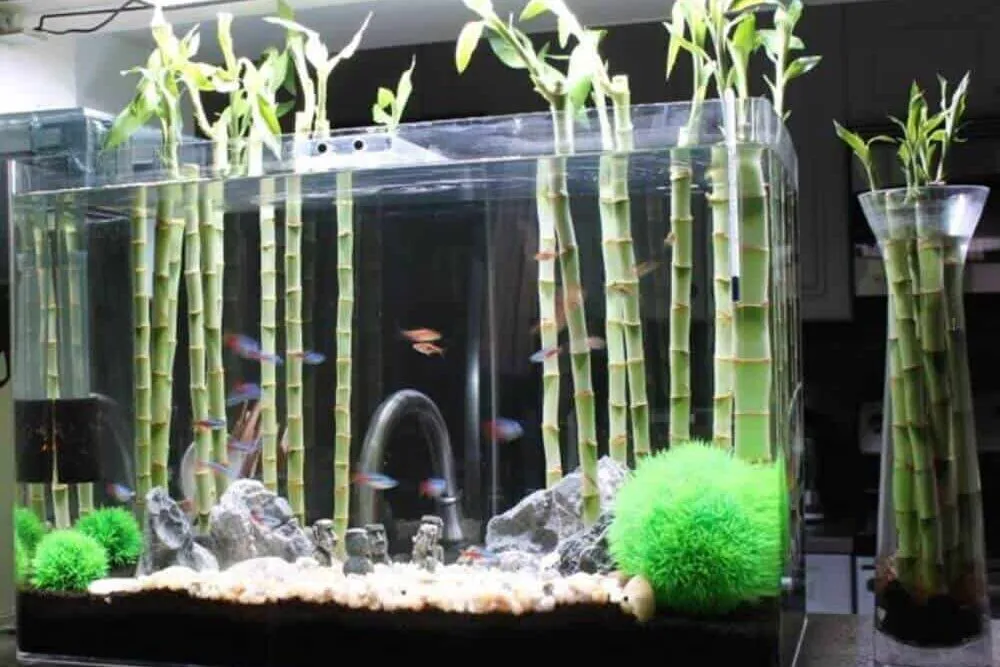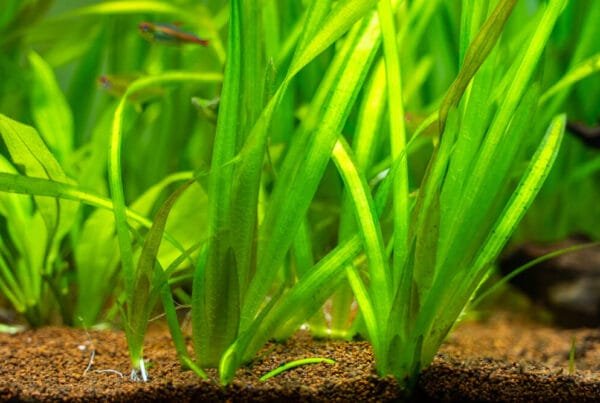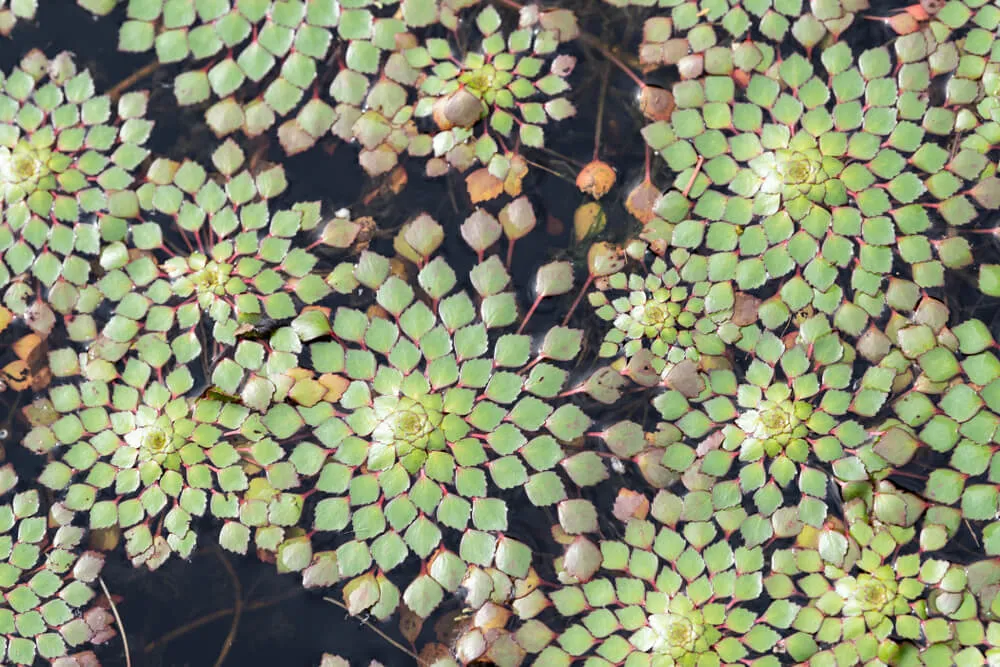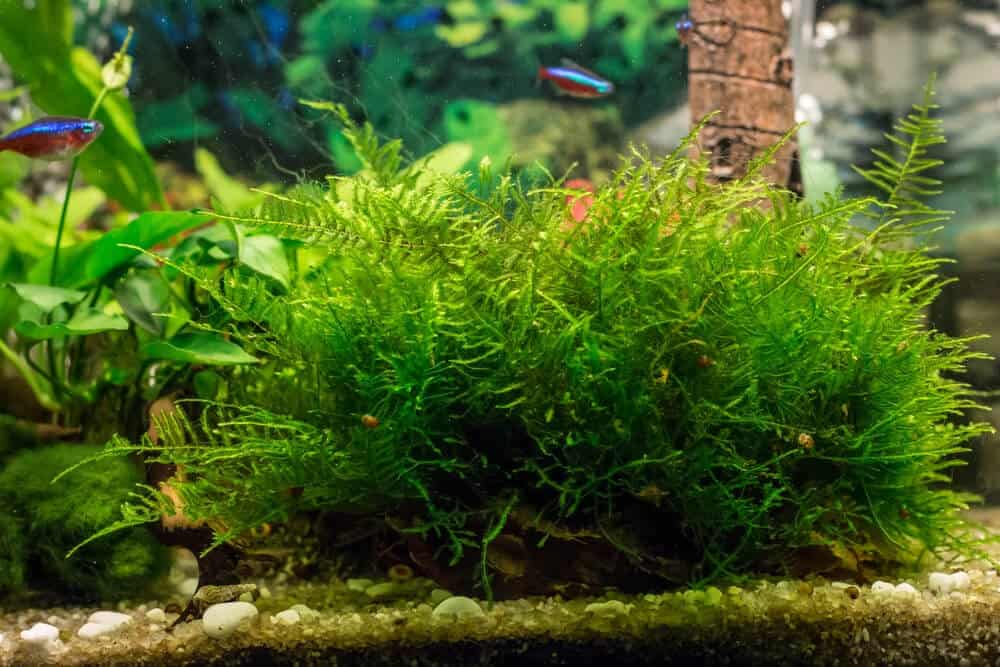Like most fish aquarium owners, you have probably thought about placing a live plant in your aquarium. But have you ever wondered whether this could be beneficial for your aquarium and its inhabitant?
Well, some plants like true bamboo are toxic and very lethal to fish. On the other hand, other plants like the lucky bamboo can prove very beneficial when introduced into a fish tank.
Despite the myths surrounding the lucky bamboo plant, it is safe for your aquarium and a great choice for spicing up your fish tank.
If you are still not convinced about planting a lucky bamboo in your tank, read this guide. Here, you will learn more about this underwater plant and whether it is a safe and viable option for your aquarium.
What Is Lucky Bamboo?
Also known as Dracaena Sanderiana, Lucky Bamboo is a houseplant that can survive in a few inches of water and does not need to be planted in soil.
Also, this plant is very easy to care for, and it can survive well in an aquarium.
This plant hails from Central Africa, specifically in Cameroon. It is a type of grass with a similar appearance to the traditional bamboo.
It has visible nodes, which are rings that separate the different bamboo sections. The stalk is strong and sturdy, and the leaves can range from a deep green color to borderline yellow.
Unlike traditional bamboo, lucky bamboo features fleshy stalks and waxy tops. These features make this plant more forbearing of wet conditions.
What Is The Difference Between Real Bamboo And Lucky Bamboo?
A common question for most aquarium owners is the difference between Real and Lucky Bamboo and whether both can be introduced in an aquarium.
Unlike lucky bamboo, you cannot put true bamboo in tank water because its roots decay or rot underwater.
True bamboo is a tall and structural grass that is not built to grow in water. The true bamboo comes from the grass family, and there are over 1,000 true bamboo species plants in the world.
It is known as the “Bambusoideae subfamily” and grows to impressive heights than the lucky bamboo. This plant also needs a lot of water and sunlight to thrive.
True bamboo dies from suffocation when its roots are submerged, and this causes a spike in ammonia levels.
If placed in the water tank, traditional bamboo will release ammonia and poison your water. The toxicity will lead to the death of your fish. On the other hand, lucky bamboo is safe to plant in your aquarium.
This plant can grow underwater, and it doesn’t rot or decay like its counterpart. However, it is worth noting that the lucky bamboo is not an aquatic plant.
What Are The Benefits Of Growing Lucky Bamboo In Your Aquarium?
There are many benefits of lucky bamboo for an aquarium owner. Some of these benefits include:
1. Filters The Water
It is essential to consistently filter and change your aquarium water to keep your fish healthy and alive. Otherwise, there will be a buildup of harmful compounds in the fish water tank that can affect the health of your fish.
Lucky bamboo serves as a natural water filter for tank waters to eliminate harmful compounds like nitrates and ammonia.
The plant absorbs the nitrates in your tank act like fertilizer to help with growth and self-repair. As a result, the lucky bamboo will thrive, and your tank water will be free from toxins, promoting the health of aquatic life.
2. Provides Shelter And Entertainment For Fish
When well maintained, lucky bamboo can create natural shelter for fish in your tank water. These plants create a peaceful environment for fish to thrive and shelter small fish who want to evade larger fish.
Furthermore, the uniquely shaped shoots can serve as a playground for fish to entertain themselves. Besides, it is sturdy and does not move with the natural water flow, allowing your fish to navigate easily.
It can be a sight to behold watching the fish swim around the twists and bends of the bamboo.
3. Adds Aesthetic Appeal To Your Aquarium
Lucky bamboo can give your aquarium a more beautiful and natural look. Besides adding health benefits, this beloved plant can add a unique touch to your aquarium and provide a stunning backdrop.
You can use them to create a natural and greener appeal that will make your tank water appear calm and peaceful.

How To Plant The Lucky Bamboo In Your Aquarium
Lucky bamboo is highly flexible and can easily adapt to various conditions, making it an excellent underwater plant.
Let’s look at some important factors to keep in mind when planting the lucky bamboo.
· Water Parameters
Lucky bamboo can be grown in freshwater that is free from any contamination. It will not grow when placed in a salty water tank.
Also, exposure to chlorine can interfere with the growth rate and cause the yellowing of leaves. Make sure that you use fresh water that is free from any contamination or waste.
Frequently change the water in the water tank and use a quality filter to ensure that it is safe for plants and fish.
When it comes to the temperature, you must maintain water temperatures of between 65 to 90 degrees F. While these adaptable plants do well in water PH ranging from 6.0-6.5, they can still thrive in an aquarium environment with a 6.8 to 7.5 PH range.
· Water Depth
Lucky bamboo plants do well when the roots are submerged in at least 2-4 inches of water. Unlike the stalks, exposing the roots of lucky bamboo to air for a long time can cause them to dry out.
· Substrate Type And Depth
Most aquarium owners maintain several inches of substrate in their water tank, which is still fine. However, the ideal substrate depth for planting your lucky bamboo is 4” deep.
Planting your lucky bamboo deeply helps with the stability and positioning of the roots. Also, it limits the chances of fish, particularly goldfish, from chewing the roots.
For substrate, you can use gravel or pebbles since they allow adequate water circulation to promote the growth and health of the roots.
Although soil substrate will deliver more nutrients, it can deprive the roots of the necessary amount of water, causing them to dry out. The roots can also develop hypoxic Dead Zones when the substrate compresses around the roots.
· Fertilizer
It is unnecessary to fertilize your lucky bamboo in an aquarium, especially if there is a high level of fish waste in the water that serves as food for the plant. Nonetheless, you can choose an aquarium-safe fertilizer like Seachem Flourish to feed your lucky bamboo.
Always read the label of the fertilizer to get the correct dosage and avoid harming your fish. Also, it is advisable to add the fertilizer in regular timeframes to ensure effectiveness.
Don’t forget to examine your lucky bamboo to measure its health. A healthy, lucky bamboo will have new and vibrant green leaves when fed with the right nutrients.
· Lighting
Like growing any other plant, it is crucial to maintain the right lighting to help the plant thrive without affecting the fish in the tank.
Lucky bamboo originates from the tropical forests in Cameroon, where they thrive in shaded areas with medium light. Therefore, the lighting for this plant in an aquarium should be low and safe. This lighting is also safe for fish in the aquarium since they are naturally sensitive to light.
Usually, the lighting in the aquarium is enough to allow your lucky bamboo to grow well. However, you should avoid using LED lights when growing your plant partially above water; otherwise, the light will burn and kill the leaves.
Also, ensure that you don’t expose the plant to direct sunlight, as this can make the leaves turn yellow and fall into the water tank.
· Aeration
Proper aeration is necessary to help your plants flourish well in an aquatic environment. Aerating your tank gives off oxygen that is useful for aerobic respiration. This is the process in which sugars are broken down and converted into energy.
To ensure this, regularly change the tank water at least once per week. Another tip is to use air stones for better oxygenation.
Some aquarium owners prefer to use filters to promote better aeration for their aquarium. Besides, aeration occurs best in large aquariums with a large surface area than in smaller aquariums.
It is recommended to oxygenate your fish tank without a pump.
· Carbon Dioxide
For lucky bamboo to thrive, there must be adequate carbon dioxide for photosynthesis. The plant will extract the CO2 from the water column. Also, you won’t need to add CO2 since the plant does not grow very fast.
Unlike contrary belief, lucky bamboo does not convert carbon monoxide to oxygen, like most water plants.
An exception is when you submerge the plant since oxygen is released from the leaves. When your plant is submerged, it will give off oxygen that your fish can use.
· Positioning Of Leaves
Basically, there are two ways that you can grow your lucky bamboo. One method is partial submersion, where the roots are submerged in water while the leaves remain above the water surface. You will need a mature plant with the right length to bury 4 inches of the plant in the substrate.
The other method involves submerging the entire plant in water, including the leaves. If you opt for this method, ensure that you provide the plant with all the nutrients necessary to keep it healthy. Otherwise, the leaves will turn yellow and eventually fall from the stalk.
Furthermore, submerged plants require high oxygen levels and moderate to high CO2.
A filter can help with the process of aeration to increase the oxygen levels in the tank. CO2 canisters can come in handy to increase carbon dioxide levels.
Ultimately, no method is right or better than the other. Whatever method you choose, you must ensure to take care of your lucky bamboo to keep it healthy.
· Trimming And Pruning
An advantage of the lucky bamboo plant is that it doesn’t spread horizontally. Also, it has a slower growth rate and managing it is very easy. Nonetheless, you may still need to trim it to remove unwanted growth.
The best thing is to trim the nodes, which are rings that separate the bamboo sections.
Is It Possible To Save A Yellowing Lucky Bamboo Plant?
Yes, it is still possible to save your lucky bamboo after it starts turning yellow.
A lucky bamboo plant can change color from green to yellow for several reasons, including exposure to direct sunlight, incorrect temperature, too much fertilizer, plant disease, or water additives.
Regardless of the reason, you can still revive your dying lucky bamboo plant.
If you notice that the leaves are changing color from green to yellow, quickly remove the plant from the water so that the leaves don’t sink to the bottom of your water tank. This also helps to prevent any decomposed matter from harming your fish.
You can place the plant in a different aquarium with fresh water.
Contaminated water lacks enough oxygen, and this could deteriorate the health of your plant. It would help if you also made some adjustments to your water tank. These may include:
- Changing the type and amount of fertilizer you use on the plant.
- Ensure that the water temperature in the tank is neither too cold nor too hot.
- Check the light directed at the plants and ensure that it is not too much.
- Examine the nitrates and ammonia levels in the water.
How Long Does It Take For A Lucky Bamboo To Grow In An Aquarium?
The lucky bamboo plant takes a while to grow, and its growth is dependent on exposure to sunlight.
Typically, this plant grows slowly and requires a lot of patience if you want it to get bigger. This plant has 10 to 12 growth phases, and each phase takes two weeks. In most cases, it takes 5 to 6 months to grow up to 19” after root development.
To promote its growth, make sure that you grow it under the right light requirement, but don’t expose it to excessive light as it can get damaged.
What Myths Are Associated With Lucky Bamboo In The Aquarium?
There is a lot of misconception about growing lucky bamboo in an aquarium. Here are some myths associated with the use of lucky bamboo in fish tank waters.
1. Lucky Bamboo Is Toxic For Aquatic Life
One misconception is that lucky bamboo releases harmful compounds in the aquarium, which can kill your fish. This is not true for lucky bamboo since it does not rot. Instead, it slows down the accumulation of nitrates that can be harmful to your fish.
However, this may not be a myth for true bamboo. When placed in an aquarium, true bamboo will rot, and this can cause an increase in ammonia levels, which can be dangerous for your fish.
2. It Cannot Be Fertilized
Most people believe that you cannot fertilize lucky bamboo as this will harm the fish. On the contrary, you can add fertilizer for your lucky bamboo plants without worrying about causing the death of your fish.
There are liquid or tablet lucky bamboo fertilizers designed to use safely in an aquarium. Nevertheless, adding fertilizer to your plants is not compulsory since they are not heavy feeders.
Furthermore, the plants can absorb the nitrates in the water for their growth and self-repair when planted in a well-cycled aquarium.
3. Bamboo Leaves Don’t Need To Be Submerged
When trying to grow lucky bamboo in your aquarium, you’ve probably heard that the leaves should not be submerged but left above the water instead.
The benefit of keeping the leaves above water is to promote better oxygen exchange. Nevertheless, lucky bamboo will still thrive well when the leaves are fully or partially submerged in water.
4. Lucky Bamboo Must Grow In A Filter
Although not necessary, you can grow lucky bamboo in your filter. Most people prefer growing the lucky bamboo in filters because the roots are submerged, and the leaves are placed above the filter line for proper breathability.
You can fill the box with gravel before placing the roots in the filter compartment and leaving the filter box cover off. With time, the plant will grow on top of your HOB filter. Also, you can use suction cups to attach the filter boxes to the side of the tank. This technique allows you to plant several lucky bamboo plants at the back of the tank.
While planting these plants in the filter promotes aeration, you should be careful since the roots may cause clogging.
Another drawback of using the HOB filter is that the roots do not eliminate toxins as effectively as regular filter media. Also, the water is prone to dust and debris since the cover is left open.
5. The Plant Will Trap The Inhabitant
This may be untrue if you ensure adequate spacing when planting your lucky bamboo. However, it is partially true for stalks that are tightly grown together. In this case, there will be no adequate space for your inhabitant to swim, and they may end up getting trapped.
Frequently Asked Questions
Is Lucky Bamboo Toxic To Fish?
No, lucky bamboo is not harmful to fish. Instead, this plant can serve as a natural habitat for fish and helps to keep their environment safe and healthy.
Unlike the traditional bamboo, this bamboo does not rot. Therefore, it does not spike the nitate and ammonia levels in the water, making it safe for your fish.
It can also protect your fish and other plants from other toxins and chemicals. It helps to absorb the two common fish waste products; nitrates and ammonia.
When left at high concentrations, these compounds can be dangerous and affect your fish’s life. Lucky bamboo prevents this by transforming these compounds into a less toxic compound.
Can Lucky Bamboo Grow In Betta Tank?
Yes, if you have a betta tank, planting your lucky bamboo should not be a problem.
Betas produce enough waste, and this means that your plant will get the right nutrients to thrive. At the same time, bettas benefit from the natural filter that the lucky bamboo plant gives. Also, this plant provides a shelter and an entertainment space where they can swim, hide, and grow.
Furthermore, they enjoy nibbling on this plant’s root tips, which serve as an excellent food source.
How Long Can Lucky Bamboo Live?
When you grow lucky bamboo in your aquarium, you can expect it to last two to three years. Of course, this will depend on the condition of your water tank.
After this period, you will be required to transplant the plant into compost or soil.
Does Lucky Bamboo Produce Oxygen?
Just like other plant species, the lucky bamboo plant photosynthesizes to produce oxygen in the presence of moderate light. When exposed to adequate LED light and water, lucky bamboo plants can give off oxygen.
The lucky bamboo gives off most of its oxygen from its leaves. So, if you want a higher amount of oxygen during the night, place the leaves above the waterline. This way, you will get the best amounts of oxygen in your room.
Does Lucky Bamboo Give Oxygen At Night?
As mentioned before, lucky bamboo releases oxygen during photosynthesis, which happens in the presence of moderate light.
If you want this plant to release oxygen during the night, ensure that it gets enough exposure to soft indoor LED lights.
Conclusion
Lucky bamboo is an adaptable plant that offers various benefits when introduced into an aquarium.
This underwater plant is worth considering if you want to improve the health of your aquarium fish and still add to the beauty of your water tank. However, it would be best if you were careful to ensure that what you plant is the lucky bamboo and not the true bamboo.
Unlike the lucky bamboo, the real bamboo has a decaying structure and can be lethal for your fish.







